 |
||
|
||
| ||
Hewlett-Packard and Pentax companies agreed upon a cooperative production of digital photo cameras. Considering rich experience of Pentax in camera production and high appreciation of their production, we should admit it to be a good step. One of the first products of their collaboration is a 2.2 megapixel camera in question. This reflex camera looks much like the traditional film one both in size and in control elements. But it's only similarity of appearance, there are still many differences between digital and film cameras. This camera is very interesting exactly in its design. Besides, it's a good manual for education in principles of photographing both on digital and classic cameras. While shooting it looks like that you are working with a usual film camera.  For a photographer it's very important to see an object and shooting parameters at the same time. That's why the information on exposure and aperture seen in the viewfinder is a pleasant feature. Of course, you can use the data given on the LCD and use the latter as a viewfinder, what is done in many digital cameras. In fact, a digital camera doesn't need an optical viewfinder, since everything shot and the shooting information are displayed on the screen. Presence of a viewfinder allows saving on the battery power by switching off the display. In general, I would call it an emulator of a classic camera or a computer photo-simulator. Although the camera looks like the film one, many technical solutions differ very much. Let's start with a reflex scheme which is not justified in digital cameras. In fact, the LC display is much more convenient in all parameters, it immediately allows seeing the information taken by the camera. And division of an image by a SLR and then, an estimation looking through the viewfinder of what the lens sees is not justified, since there appeared an additional difficulty in adjustment: you need to adjust the track of a viewfinder preciser in order it to coincide with an optical track of the camera. In a film camera it's justified since the film fears light, therefore you can't look in the film channel what image gets into the snapshot. You can of course set opal glass instead of the film, what is sometimes done in some models of studio cameras, but it's only for slow shooting. A digital camera gives a unique opportunity to look at the image created by a matrix while focusing, and then with its help to receive a shot. So, the matrix seems to play roles both of opal glass and of a film. A viewfinder of a classic camera has two main functions: to see the same what the lens sees and to set the sharpness. It means that on the opal glass in the viewfinder, like in the magnifier, you examine an image which is located at the same distance from the lens as a film in the film channel. In this camera an optical viewfinder is based on the principle of the opera glasses, i.e. you are looking not at the real image on the opal glass but a virtual image with an eyeglass. This scheme allows seeing exactly those images that are seen by the lens even if different attachments are used but without setting the sharpness. The SLR is stationary, and the viewfinder is covered with a shutter, but in the wrong time. If shooting with a flash, then, it could be seen in the viewfinder. You know that in a usual reflex camera the flash is never seen - when a film is exposed, the SLR is lifted up and nothing could be seen in the viewfinder.  The shutter must prevent the matrix from the light which can get inside through the viewfinder. But as it's shuts a bit later it doesn't prevent properly the matrix, and the bright light can get onto the matrix. It seems that a lid covering the eye glass of the viewfinder and entirely preventing the matrix from light is inteded exactly for this purpose. Adjustment for your eyes is made with turning the eye glass, that's why taking the lid you can easily destroy the adjustment. The fact that the SLR is stationary makes us assume that the considerable part of light is lost. The matrix here seems to be not very sensitive since the sensitivity range is from 25 to 400 ISO. The standard value is 100 ISO, and considering the fact that there are a lot of steps before this value, I think that the real sensitivity is somewhere 50, like of the majority. The half is "eaten" by the SLR, that's why its standard sensitivity is 25, and this value is to be taken for shooting. The shots show that in shadows the camera has great noise. Althout the lens is unexchangeable, possibilities to widen a focal length range are high. Lens thread for color filters M49 allows using afocal attachment of many manufacturers developed also for video cameras. It gives not brillient quality but allows understanding what's for what. Now comes the lens. Its focal length changes with an electric motor. Why do they implement t in digital cameras? In video cameras, for example, it's very useful, since it's necessary to prevent jerks while shooting. It seems that it's connected with economy. At today's stage of development a motor doesn't cost anything. And uniform loads considerably decrease requirements for materials used for lens construction. Sharpness setting is done also by an electro drive with a help of a mini-joystick on the rear panel. The manual focusing is descrete 0.2, 0.3, 0.5, 0.7, 1.0, 1.5, 3.0, 10 m and infinity. The distance is shown on the LC display. The display rotates what is very convenient and allows using it as a viewfinder. You can shoot at the level of waist seeing the image at the right angle what is especially important for LCDs changing a visual angle might lead to the contrast and brightness to be terrible. 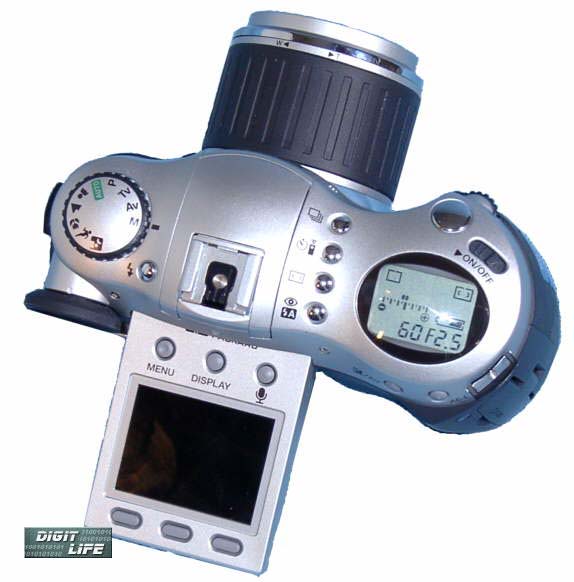  Now up connection to a computer and other devices. You can do it via USB port, and since the camera is quite big, it's connected with a standard cable. Besides, they included a possibility to transfer data via an infrared port. So, you can transfer data from camera to camera, to printer and computer (a sign with a paper pegion), where they are taken by a program. When I first transferred data to the computer, I managed to record a frame of a completely non-standard format 1300X1024 pixels, considering that the menu provides only two 1600X1200 and 800X 600. The record is possible in TIFF and JPEG formats.  The menu switch contains 4 positions: shooting, viewing, operations with takes and connection with a computer. The latter is necessary only when connecting via USB. The flash, like in most reflex cameras, rises above the lens. Besides, there is a standard connector with one central pin for connecting an external flash.  Control elements are rather convenient. On the upper panel your forefinger will touch a switch for camera and a release button. Under the release button you will find a wheel for changing exposure and aperture. If in manual mode you will press a special button with your thumb, then you can change an aperture, and if released, the exposure will be changed. In other modes this wheel allows changing that parameter which is set to be leading. Right behind it you will find an LC indicator showing exposure, aperture, the number of remaining frames, battery status and made exposure correction or (in manual mode) deviation of the set parameters from the recommended by the automatics. To the left there are buttons for switching either single or serial shooting, timer and remote control, autofocusing zones, flash modes. The AĊ LOOK button intended for thumb allows fixing exposure parameters for 20 seconds. The camera is supplied with an infrared remote control which implements only releasing the shutter. On the rear panel there is an LCD with three buttons above and three below. The upper buttons are menu, display, microphone (the camera can record sound comments for each shot), the lower buttons depend on what is shown on the display menu. Next to it there is a wheel of modes: record, reproduction, work on shots, computer and mini-joystick for navigating menu. Menu writings can be in three languages. There are the following options: white balance, auto, daylight, tungsten lamps, fluorescent lamps and 5500K. The possible choise of the ISO is 25,50,100,200,400. The camera sets exposure and aperture according to the chosen ISO. Comparison with the exposure menter of the CANON EOS 50 camera doesn't reveal significant differences in choise of exposure at the established sensitivity values. In playback mode on the LCD you can see the shot, exposure and aperture values, time and a number of the shot. There is a possibility of slideshow. A search of the shots are carried out according to the date and category.  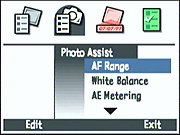     Shooting   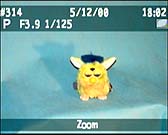 Playback On the bottom part of the camera there is a tripod seat and a bay for batteries. It seems that the clamps holding the lid of the battery's bay are rather weak; but during the test they didn't fall off. The camera feeds from 4 AA batteries, rechargeable ones are preferred. I should note that the camera comsumes a lot. Interestingly that the external power supply unit is not 6V but 9V. With 6V it won't work. Tests
Resolution
 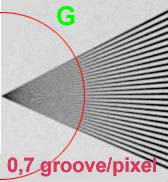  Moire structure depends on the channel, however it slightly tells upon the resolution. Spectral charactristicsThe specrum of KGM 250 hologen lamp obtained with the help of diffraction grating. The red line corresponds to 632.8 nm wavelength.  A shot of the GretagMacbeth test table taken with automatic white balance and lighting with the native flash. Comparing it with the shot of the spectrum it's easy to see that although the camera doesn't take clear yellow and blue colors, it perfectly performs it in colors. In my opinion, the shot of the table is useful only for estimation of color reproduction when retaking prints made in printing-house. Currents in different modes:
Technical characteristics
Photo
Frame miniatures taken from one point with different focal lengthes and different optical attachments.
 Lens with f=25.8mm  Lens with f=8.2 mm  Lens with f=25.8mm+ hama HR-1,5x f=25.8x1,5=38.7mm 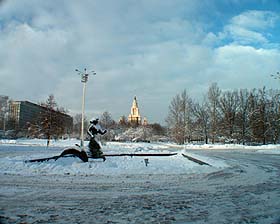 Lens with f=8.2 mm+ hama HR-0.65x f=8.2x0.65=5.3mm
Write a comment below. No registration needed!
|
Platform · Video · Multimedia · Mobile · Other || About us & Privacy policy · Twitter · Facebook Copyright © Byrds Research & Publishing, Ltd., 1997–2011. All rights reserved. |